September 29th, 2022
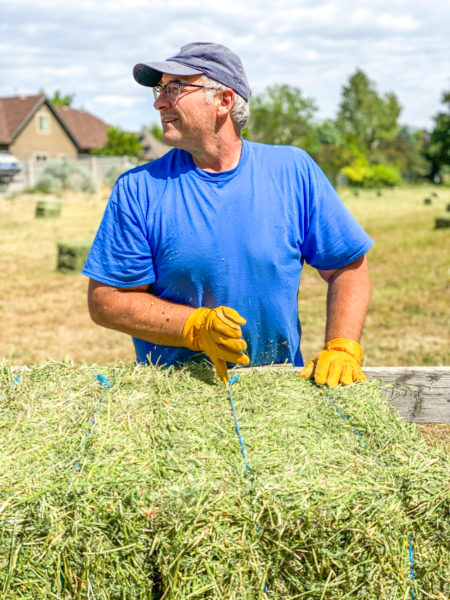
Ron Russon bailing hay on the Utah farm that’s been in his family for five generations
With a show opening next month, Ron Russon‘s artwork is on our minds and we wanted to share this blog from 2021. Enjoy — and mark your calendars for an end-of summer September 30th Artist Reception, where you can meet the artist in person.
Looking at the abstract expressionist wildlife paintings of Ron Russon, one may not expect the modest, humble man behind the canvas. His art needs no background information to be appreciated, but an understanding of his life and story only enhances the wonder behind the sophistication and beauty of his work.
A conversation with Ron Russon is sure to dissipate any preconceived notions you may have held about what it means to be an artist or what it means to be a farmer. His life blends the worlds of fine art and agriculture into a colorful, textured world of multitudes. During our conversation with the artist, he muses on the shortcomings of Norman Rockwell’s more traditional painterly style with the same quiet wisdom as he exhibits when discussing creative approaches to mending odds and ends around the farm (something involving an old boot, bailing twine, and an oil can). His commentary on the energy and gravity of the works of Jackson Pollock is offset by the faint sounds of chickens clucking in the background.
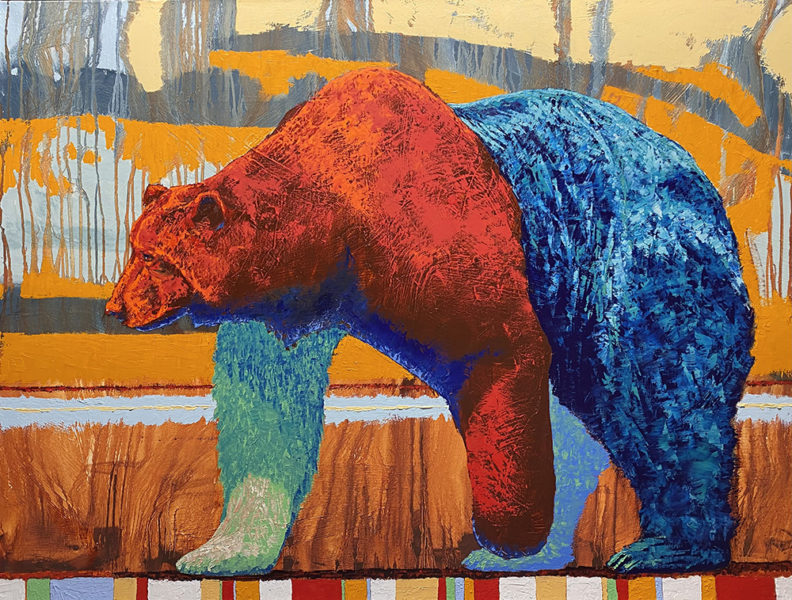
Ron Russon, “Colors of Bruin Life,” 36″ x 48″, oil
The union of these seemingly contrary worlds results in bright, colorful, highly texturized works of art, which pay homage to the nature and land that he loves and cares for, while simultaneously pushing past the limitations of the natural world into the boundlessness of imagination. Although his work may be all too familiar and beloved by our collectors, it’s come to our attention that we had never given him a proper in-depth introduction on our blog, so this time, when we spoke with oil painter Ron Russon, we started from the beginning.
Raised in an agricultural, rural setting, Ron Russon grew up thinking “if you can’t live it, eat it, produce it, how could you make a living?” Growing up, Ron Russon was 1 of 5 boys, “The Russon Boys” as they were known in their town. In their community, “The Russon Boys” were perhaps best known for their strength — they were the ones you called when you needed help moving heavy things (their piano moving count is somewhere in the upper 30s). No stranger to hard work, Russon was prepared for a hard-earned life in any career that could provide him and his future family a living.
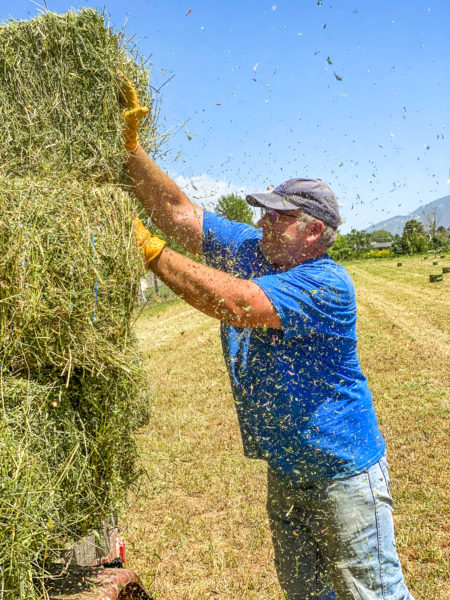
Ron Russon bailing hay on his farm in Utah
As a child, he loved art as much as any kid does, but he never considered art as a practical profession. That was until he went to college at Utah Valley University where he first “tried every major under the sun.“ “I tried to avoid art,” Ron Russon says, recalling, “I avoided it because I thought it just wasn’t viable.” He chuckles as he observes the way his love and talent for art haunted him. “In a good way!” he assures us, “like Casper the friendly ghost coming by all the time.” Eventually, the friendly ghost of art caught up to him.
This came in the form of a college elective class. Still unsure of what he wanted to do at the time, Russon signed up for various eclectic electives simply for the fun of it. He took ballroom dancing, scuba diving, and finally, art. His drawing class at UVU gave him an opportunity to sit with his work more than he ever had before. “It was quiet, and it gave me time to study and draw,” Russon remembers, “It was like a little ‘click’ happened in my brain… or in my soul. It told me, ‘you’re stuck. This is it.” He laughs as he recalls thinking, “Aw man, really? Art?!”
Once art finally caught up to him, Russon decided to take his studies to Brigham Young University. There he submitted drawings to BYU’s competitive Illustration Design program. To him, Illustration Design was just practical enough to justify a career in the arts in his mind. To his surprise, he was accepted into the program.
At the time he was accepted into BYU’s Illustration Design program, he had never painted before in his life. Russon had only dabbled with graphite and charcoal. Color was completely unfamiliar territory to him. “It was like jumping into the deep end,” Russon says, “and I didn’t have anything to swim with.” There in his classes at BYU, Ron Russon learned how to swim with color. After the first year of the program, students must resubmit their portfolios to be considered to stay in the program. Russon was relieved to make it past the first cut, earning him another year of the program.
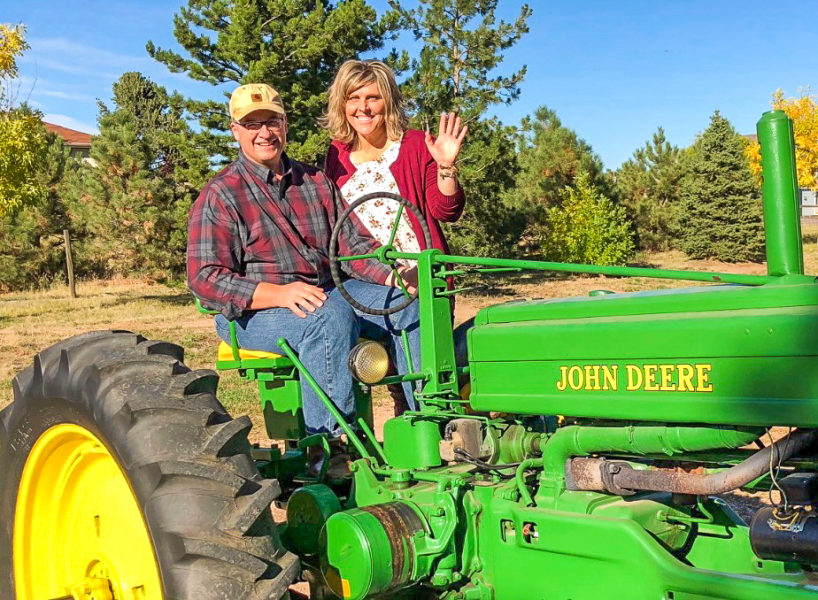
Ron Russon and his wife on their farm’s tractor
While Russon was enrolled, he was still working at a dairy farm to help pay for his schooling. “I had to work hard to make ends meet,” Russon says. One night as he drove to the dairy farm from school to milk cows, Ron Russon’s life took an unexpected, tragic turn. “I got hit by a truck,” he says, “and it messed me up pretty bad. It broke my neck, and I should’ve died.” As Russon describes this horrific accident, his rather calm and casual tone almost masks the severity of the incident. “I’ve got titanium holding me together,” he elaborates coolly, “and they had to bolt my neck back together.“ He glosses over this detail, instead focusing on the tragedy of his car’s disfiguration. “It was really horrible because I had this beautiful car — a shiny blue ‘75 Volkswagen… with a sunroof!” he says, “so yeah, it was a rough patch.”
Immediately after Russon’s car accident, the doctors didn’t quite know what to expect from his recovery or whether he would make it through. “I was sitting in a bed for a couple of weeks and was told that if I moved at all, I was going to die,” Russon says, “It provides you with an opportunity for reflection.” With ample time for introspection, Russon had a chance to reevaluate his priorities. He considered who he wanted to be. Did he want to be the farmer or did he want to be the artist? It was while there, sitting in bed recovering from tragedy that he realized that perhaps, just maybe, he didn’t have to choose. “I think that farming is inherent for me. I’ll always be a farmer, because that’s just who I am. But the reality was that art was what I needed to do. Suddenly, it really did become a need. It became an answer to a purpose.”
After his recovery, with this decision in mind, he returned to school to finish his art degree. “I had to work extra hard to make up for lost time,” he remembers. Jumping back in with his education, he worried that he might lack the skill set for any one media in particular. To make up for that, he tried everything. “I had nothing to draw on except for trying itself, so I tried acrylic, I tried watercolor, I tried oil, I tried pastels, I tried everything.”
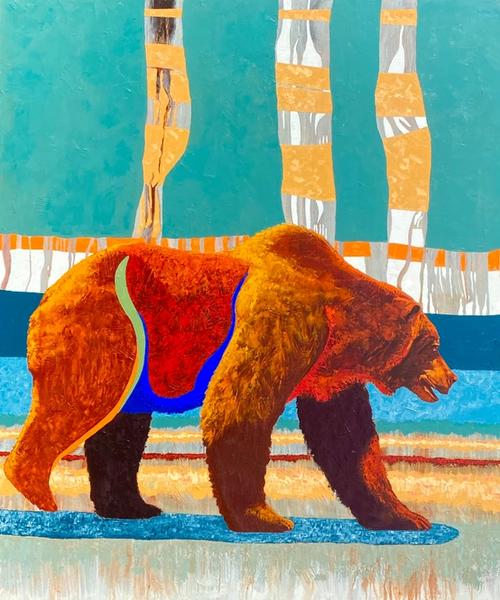
Ron Russon, “On the Hunt,” oil, 72″ x 60″ (sold)
Before his days of artistic experimentation, Russon’s first artistic influences and role models were more traditional illustrators like Norman Rockwell. “When I first started out, I wanted to be the next Norman Rockwell, because everyone smiles when they see his work.” Russon says. Upon further reflection, he realized an important distinction: “Then it occurred to me that people smiled when they saw his work more because of his content than because of his actual craft and style.”
It was around this time in his art education that Ron Russon was first exposed to more contemporary artists. He pursued an internship in New York for six months. There, at the Met and Whitney and all of the other modern art museums New York City has to offer, Russon saw the work of Abstract Expressionists in person for the first time, including the work of Jackson Pollock. “Growing up, I knew Jackson Pollock as ‘that paint bucket thrower guy,’” he laughs, “To me, it was almost farcical to think about. However, when you see his work in real life, there’s thought, there’s a rhythm, there’s something to it. There’s a spirit or an energy to his work that I suddenly understood, standing before it. I finally saw it and there really was something to it.” He started to see contemporary artists and their modern art styles in a new light. “I saw that they all had something to say and that they all had different ways to say it. I think about that and dwell on it, and now I respond to it with my work,” he says.
Taking that experience with him, Russon graduated from BYU to work in conceptual illustration. Only a few weeks out of college, Russon started getting calls from magazines wanting illustration work done. His first few jobs were working on illustrations for various magazines: computer magazines, golf magazines, spy magazines, and more. His decision to pursue an art degree suddenly didn’t seem like such a crazy, impractical idea. At that rate, he imagined how his life and career would go: he would illustrate for magazines and go fishing in his spare time. “Life was pretty groovy then,“ he reminisces.
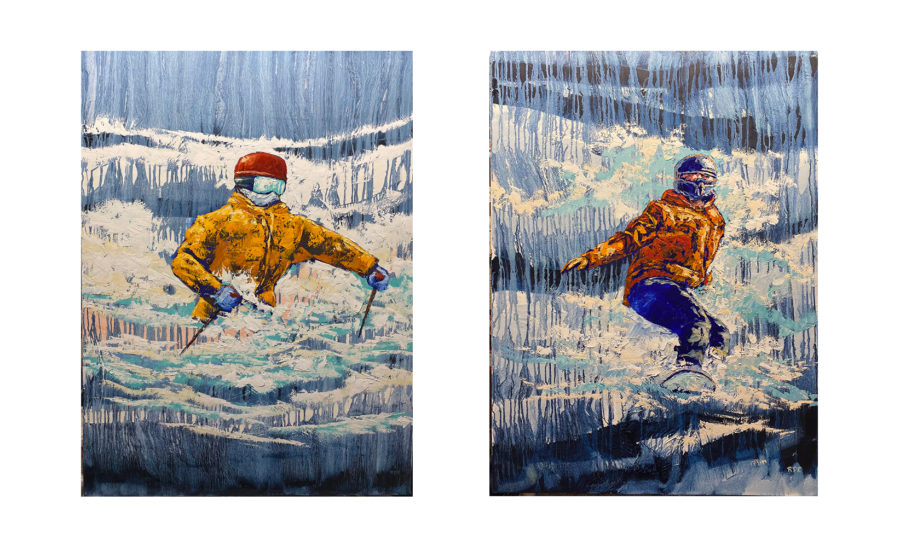
“Frozen Freedom” and “Cold Carving” by Ron Russon, oil
Then about his second or third year out of school, the art illustration world shifted. It then became common practice for artists to scan images onto a disc and sell unlimited usage of their illustrations with the purchase of that disc. Suddenly, an illustration job that was once worth $2,200 soon dropped to $300 within the same year. Magazines no longer purchased individualized illustrations from artists. Instead they were purchasing generic illustrations on discs and altering the images slightly to fit their purposes. Magazines’ illustration budgets plummeted, as did the livelihoods of many illustrators. “The writing was on the wall for me and my conceptual illustrations,” Russon says. He had to move on and find alternate ways of supporting himself with his work.
He decided to turn to painting fine art to fulfill that need, financially and emotionally. “I always had a pension for the outdoors and nature so I just started to paint en plein air,” Russon says. Initially, he had some limited success with his paintings. They began selling in a few small galleries, but it was still a slower start than he would have preferred.
In Jackson Hole, Wyoming, Russon was selling paintings of bears and American bison. His paintings were beautiful, but still in keeping with the more traditional realism of his early influences. However, by the umpteenth painting of the same brown bear, Ron Russon confesses he was… bored. “I needed more,” he says, “so I thought, ‘well, why don’t I just try doing whatever I want.’” So, he painted a bear in bright cadmium red. With this move, Russon experienced the same “click” that he had felt when he first discovered his passion for art. This new artistic style — somewhere between the exciting, unnatural colors of Fauvism, the wild energy of Abstract Expressionism, and the painterly strokes of Impressionism — felt right to him.
Ron Russon resolved to continue experimenting and to continue pushing the boundaries of his style. “It was the answer I needed to get out of the same boring rut and into the personal work — the work that answers the question, ‘what is my voice in this world?’” He elaborates, “If my voice is to just add some more pleasant noise, then okay, but it seemed to me that my voice was different than that. It’s a necessity to express that voice in the way of painting, and that’s what I do now.”
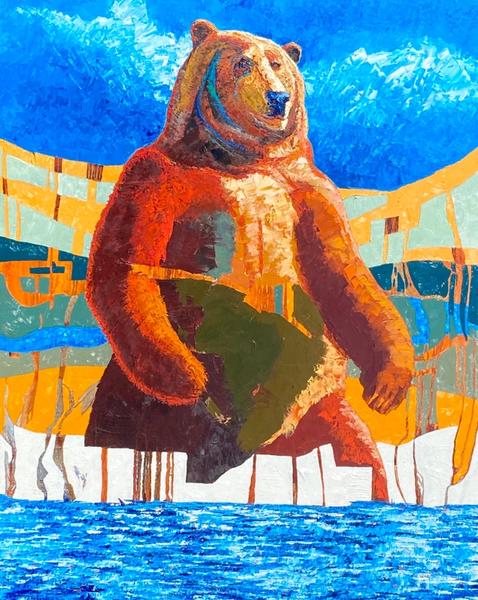
Ron Russon, “No Apologies,” oil, 60″ x 48″
That sense of experimentation and mixed media exploration continues to seep into Ron Russon‘s work. Although his paintings are predominantly created with oil paint, they have a mixed media quality to them, in large part due to his treatment of the materials. He applies rough, “gnarly” gesso to the surface of his canvases before starting painting, intentionally creating interesting and unusual streaks and lines with the gesso. With his highly textured surface primed and ready, he then begins blocking out his subjects’ proportions and shape, never fully detailing the entire painting. Instead, he leaves room for suggestion and intrigue through a balance of refinement and loose non-objectivity. He allows his paint to drip, and he flows along with the textures as they arise. “I want some elements hidden and found,” he says, “For me, it’s part of the process to simply respond to the paint.” With energetic brush strokes, he applies vivid colors of paint to his subjects, preferring the energy of the unnaturally dynamic hues to realistic ones.
Ron Russon is grateful to be represented by a gallery that not only appreciates, but encourages that kind of artistic experimentation. “l feel very fortunate to have shown at Gallery MAR since almost the beginning,” Russon says, “I’m honored to still have a great working relationship with Maren Mullin and her team. I’m always impressed by Maren for being courageous and bold. She has a keen, discerning eye and an equally keen business mind. Gallery MAR feels like home for me and my work.”
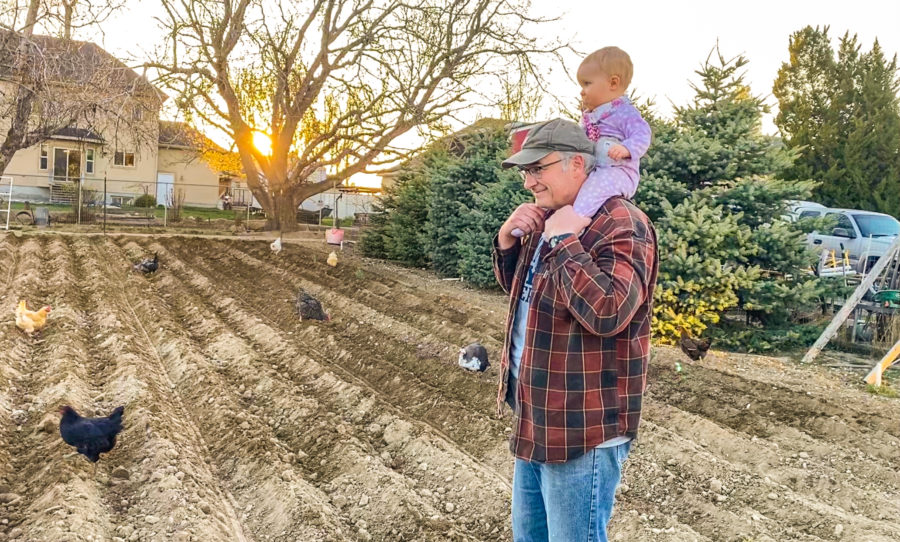
Ron Russon and his young daughter watch the chickens roam as the sun sets on their farm
In addition to balancing his studio art practice with his farming, Russon is also entering the world of fatherhood at the age of 53. His daughter, 3, and his son, 1, have added to the richness and the complexity of his already busy life. He sums up this new chapter of his life in one word: “tired.” Together, he and his wife take shifts with their children, but even so, his studio practice has been understandably changed. “Holy cow,” Russon says, “Gone are the days of leisurely painting, staring at the canvas, following the muse, and letting it happen. Now, when I have studio time, I make the most of it, that’s for sure. Parenthood has forced me to get in the studio and get after it. Then again, there’s something to be said about brush mileage: the more I paint, the better I get. So if I need to work things out, quicker is better anyways.”
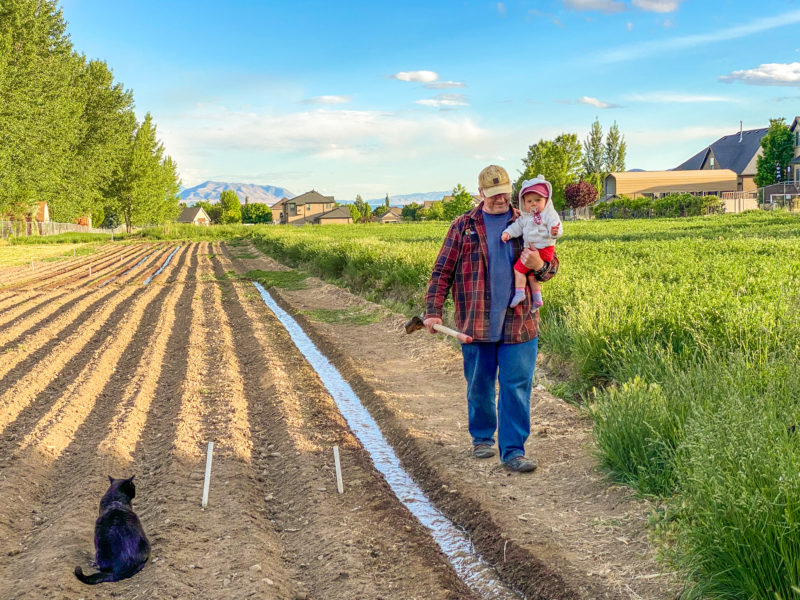
Ron Russon balances farming, painting, and fatherhood on their beautiful farm
Russon and his wife are raising their kids on the same farm that’s been in his family for generations. “I’m a fifth generation farmer on the same dirt,” Russon says, “I think it’s in my DNA. Once you’re part of that cycle of growing… there’s just something about that life. It’s amazing.”
As for his painting life, Russon says with gratitude, “my voice is becoming more my voice. It’s growing stronger and stronger the more I paint. As you step more confidently into your authentic genuine voice, then the finished result will always be good.” As Ron Russon blends the agrarian with the artistic elements of his world, he sets an example for us all of what it means to live life with great purpose and authenticity.
We would like to extend a special thank you to Ron Russon for his time, story, and insights.
Original piece written by Veronica Vale
Posted in Utah Art News
 Picture This: 2025 Interior Design Trends
Picture This: 2025 Interior Design Trends Motion & Modernism: Introducing Artist Clinton Whiting
Motion & Modernism: Introducing Artist Clinton Whiting Meredith Young Sundance Pop-Up 2025
Meredith Young Sundance Pop-Up 2025